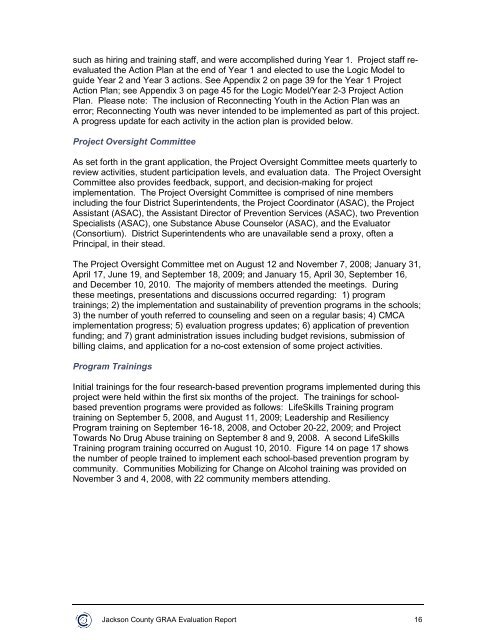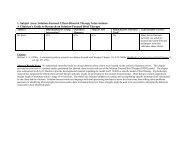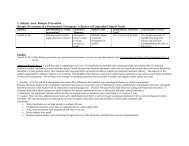Jackson County Program Evaluation Project Year 3, Report 1.pdf
Jackson County Program Evaluation Project Year 3, Report 1.pdf
Jackson County Program Evaluation Project Year 3, Report 1.pdf
Create successful ePaper yourself
Turn your PDF publications into a flip-book with our unique Google optimized e-Paper software.
such as hiring and training staff, and were accomplished during <strong>Year</strong> 1. <strong>Project</strong> staff reevaluatedthe Action Plan at the end of <strong>Year</strong> 1 and elected to use the Logic Model toguide <strong>Year</strong> 2 and <strong>Year</strong> 3 actions. See Appendix 2 on page 39 for the <strong>Year</strong> 1 <strong>Project</strong>Action Plan; see Appendix 3 on page 45 for the Logic Model/<strong>Year</strong> 2-3 <strong>Project</strong> ActionPlan. Please note: The inclusion of Reconnecting Youth in the Action Plan was anerror; Reconnecting Youth was never intended to be implemented as part of this project.A progress update for each activity in the action plan is provided below.<strong>Project</strong> Oversight CommitteeAs set forth in the grant application, the <strong>Project</strong> Oversight Committee meets quarterly toreview activities, student participation levels, and evaluation data. The <strong>Project</strong> OversightCommittee also provides feedback, support, and decision-making for projectimplementation. The <strong>Project</strong> Oversight Committee is comprised of nine membersincluding the four District Superintendents, the <strong>Project</strong> Coordinator (ASAC), the <strong>Project</strong>Assistant (ASAC), the Assistant Director of Prevention Services (ASAC), two PreventionSpecialists (ASAC), one Substance Abuse Counselor (ASAC), and the Evaluator(Consortium). District Superintendents who are unavailable send a proxy, often aPrincipal, in their stead.The <strong>Project</strong> Oversight Committee met on August 12 and November 7, 2008; January 31,April 17, June 19, and September 18, 2009; and January 15, April 30, September 16,and December 10, 2010. The majority of members attended the meetings. Duringthese meetings, presentations and discussions occurred regarding: 1) programtrainings; 2) the implementation and sustainability of prevention programs in the schools;3) the number of youth referred to counseling and seen on a regular basis; 4) CMCAimplementation progress; 5) evaluation progress updates; 6) application of preventionfunding; and 7) grant administration issues including budget revisions, submission ofbilling claims, and application for a no-cost extension of some project activities.<strong>Program</strong> TrainingsInitial trainings for the four research-based prevention programs implemented during thisproject were held within the first six months of the project. The trainings for schoolbasedprevention programs were provided as follows: LifeSkills Training programtraining on September 5, 2008, and August 11, 2009; Leadership and Resiliency<strong>Program</strong> training on September 16-18, 2008, and October 20-22, 2009; and <strong>Project</strong>Towards No Drug Abuse training on September 8 and 9, 2008. A second LifeSkillsTraining program training occurred on August 10, 2010. Figure 14 on page 17 showsthe number of people trained to implement each school-based prevention program bycommunity. Communities Mobilizing for Change on Alcohol training was provided onNovember 3 and 4, 2008, with 22 community members attending.<strong>Jackson</strong> <strong>County</strong> GRAA <strong>Evaluation</strong> <strong>Report</strong> 16






